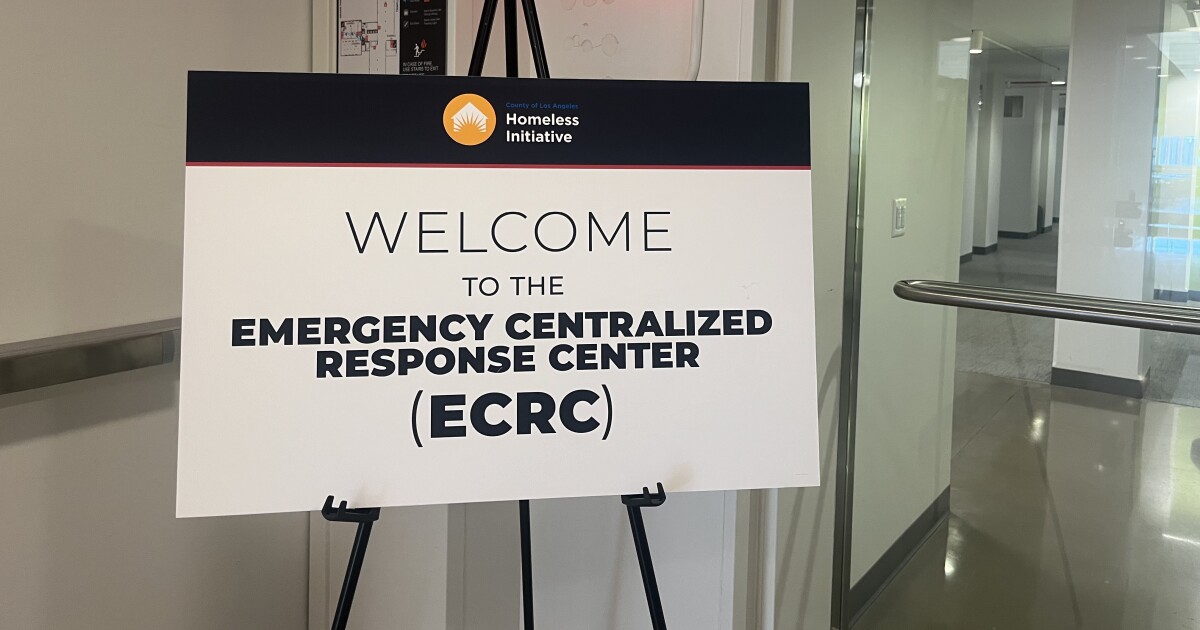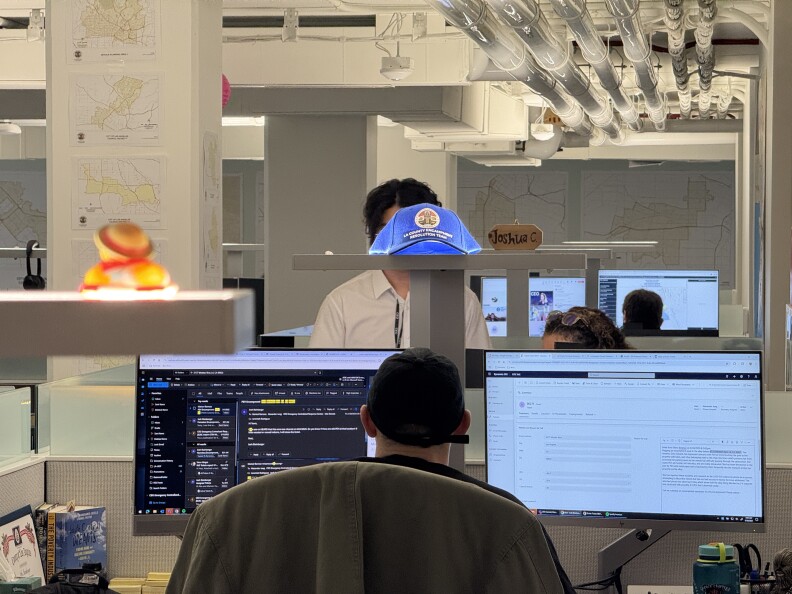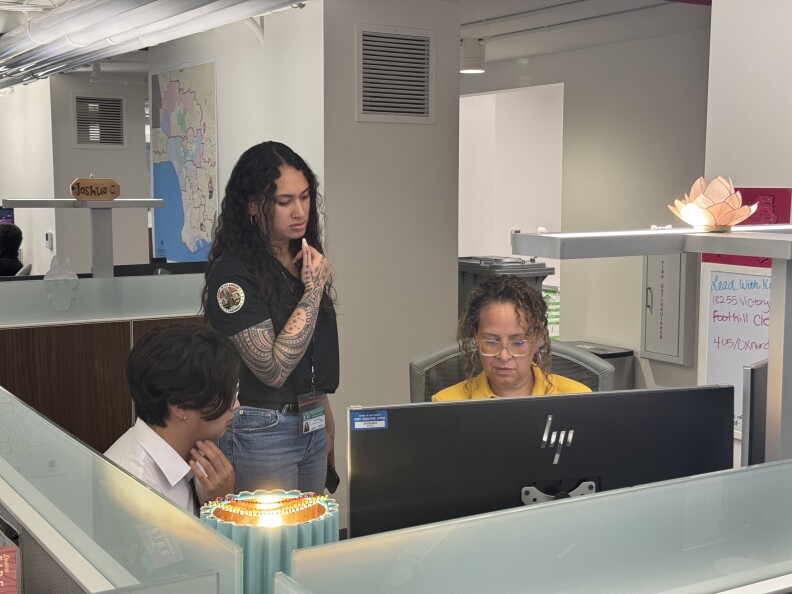Keep up with LAist.
If you’re enjoying this article, you’ll love our daily newsletter, The LA Report. Each weekday, catch up on the 5 most pressing stories to start your morning in 3 minutes or less.
Los Angeles County’s first centralized dispatch center to quickly connect unsheltered people with housing, treatment and other services will start taking requests from the public on Tuesday, according to officials.
The county’s Emergency Centralized Response Center (ECRC) started operating in January to centralize intake to the various services and programs for unhoused individuals run by a host of county and city departments, agencies and outreach teams.
Since opening, the center has responded to 436 referrals, according to county officials. One referral can include multiple unsheltered people, they said.
So far, the center has only taken referrals from elected officials and governmental agencies.
But that’s changing on Tuesday, when the public will be able to submit reports to the center through LA-HOP, a homeless outreach portal that was previously run by the Los Angeles Homeless Services Authority. Based on county data, this could lead to a significant increase in the number of requests to the new dispatch center.
Officials gave a tour on Thursday to reporters and took questions.
Before the center was created, “you would have all of these outreach teams descending upon this one site [of an encampment], which is not a good use of resources,” said Elizabeth “Libby” Boyce, who oversaw the implementation of the dispatch center.
As a centralized information hub, officials say the dispatch center can now coordinate across several agencies and teams to receive requests for services and direct a group of 150 outreach teams to help provide timely interim housing and necessary support to unsheltered people.
When county supervisors decided to pull hundreds of millions of dollars of homeless service spending from LAHSA — a joint city-county agency — and instead have the county directly oversee it, city leaders expressed concern that the city and county would lose coordination of their efforts.
During Thursday’s tour, officials pointed to the expanding dispatch center as a place where both governments work closely together.
L.A. City Councilmember Nithya Raman, who chairs the council’s Housing and Homelessness Committee, said she’s hopeful the coordination will lead to better outcomes.
“By establishing an Emergency Centralized Response Center we will be able to expand our access to data, increase both accountability and coordination, and ensure that every dollar we are spending as a city — and by extension we as a region — is going further,” Raman said.
ECRC teams working on processing homeless service referrals and dispatching outreach teams.
How it works
At the ECRC, four teams are responsible for processing referrals — or requests for services — dispatching and supporting teams and updating referrals, county officials said. Each team handles requests for two of the county zones known as service planning areas.
There are also representatives on site every day from the county’s departments of Mental Health, Health Services, Public Health, Substance Abuse Prevention and Control, Military and Veteran Affairs and Social Services, as well as LAHSA and L.A.’s City Administrative Officer, according to the county.
The dispatch center also helps coordinate encampment solution efforts such as Inside Safe and the county’s Pathway Home program, as well as teams that conduct cleanups in unincorporated areas, officials said.
Together, all of these departments, agencies and individuals combine their resources to provide relief efforts, officials say.
The new dispatch center has recently been providing their services in Whittier Narrows, a large park in the San Gabriel Valley.
“There are so many entities that have a footprint there,” Boyce said. “You have [state] Fish and [Wildlife], you have the Army Corps of Engineers, you have unincorporated [county], you have this city… you have Caltrans — somebody’s got to facilitate a discussion with all those people, which we’ve been doing.”
The dispatch center’s director, Donald Holt, also pointed to the multi-jurisdictional Ballona Creek in West L.A. He said the dispatch center coordinated meetings with multiple local law enforcement agencies, which were able to move unsheltered people from the area while connecting them with services.
Before the center’s creation, the various government entities would have received separate calls and enacted separate operations in Ballona Creek. This lack of communication would leave pockets of the area uncleared, with unsheltered people moving from jurisdiction to jurisdiction.
Ultimately, Donald said they were able to engage with about 45 people and get 15 indoors in Ballona Creek in one day by coordinating with multiple agencies.
Boyce said the center now collect information information daily about available beds across the county from publicly-funded interim housing providers — which she said hovers at around 30 to 50 beds — allowing the dispatch center to provide unsheltered individuals with interim housing options even when there are no available beds in the specific jurisdiction they’re located in.
And unlike previous intake approaches, county officials say the new dispatch center updates the person who requested a referral. Officials say that’s part of their effort to build a “feedback loop” that builds trust.
For instance, instead of getting an automated response informing them when their LA-HOP ticket is closed, people will receive real-time information about what resolution programs are being planned in response to their request, officials say.
Members of ECRC teams working together at a computer.
Put to the test
The ECRC welcomed its first staff members on Jan. 3, Boyce said. Four days later, wildfires erupted across Southern California.
“We had to jump in,” Boyce said. “We’re an emergency entity — if there’s a natural disaster, if there’s any emergency, we can be the conduit to the unsheltered, we can be the messenger. And that happened with the wildfires.”
Ultimately, in January the dispatch center worked to evacuate 17 interim housing shelters, supplied more than 6,000 N-95 masks and relocated 500 people, Boyce said.
L.A. County Supervisors Lindsey Horvath and Kathryn Barger proposed the ECRC in a motion approved by the Board of Supervisors in September.
“We’ve gone from a motion in September to a space that was operational in December and then responding to the county’s largest-ever disaster by January,” Horvath said. “I cannot really stress enough how unprecedented [this is].”

Supervisor Horvath speaking to reporters at a panel on Thursday.
Looking to the future
As the dispatch center expands, officials there say they aim to focus on building trust through engagement.
“Most of the individuals that are experiencing homelessness in [an] area, they have ties in that area… and so they’re very reluctant to leave,” Holt said. “There are just some areas where the resources are extremely scarce, and so you have to continue to try to build that rapport, and hopefully they’ll be receptive to relocate.”
Officials say they’d welcome additional government agencies to send staff to the center.
“If any city or municipality wants to come and join us, they may, and then we can help be a little bit more direct with helping them with their unsheltered issues,” Boyce said.
With the anticipation of a surge of new requests when the dispatch center opens to the public, Boyce said she is confident their team is prepared to respond.
“We have room for more, and we’re ready to take it on.”
[Have you had an experience with the county’s new dispatch center? Contact our reporting intern Kahani Malhotra at kmalhotra@scpr.org.]
Nick Gerda contributed to this report.


